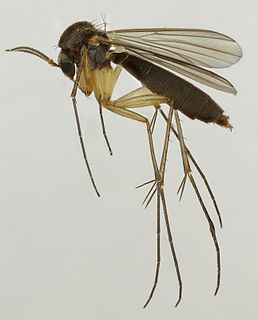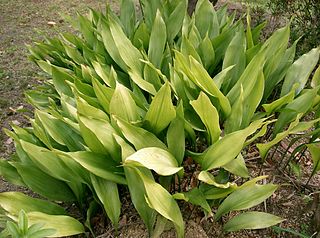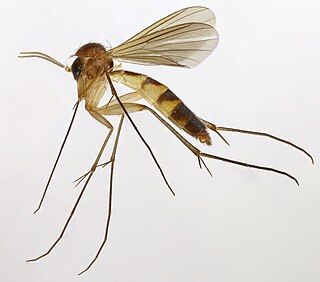
The Nematocera are a suborder of elongated flies with thin, segmented antennae and mostly aquatic larvae. Major families in the suborder include the mosquitoes, crane flies, gnats, black flies, and a group of families described as midges.

Fungus gnats are small, dark, short-lived gnats, of the families Sciaridae, Diadocidiidae, Ditomyiidae, Keroplatidae, Bolitophilidae, and Mycetophilidae ; they comprise six of the seven families placed in the superfamily Sciaroidea.

The Mycetophilidae are a family of small flies, forming the bulk of those species known as fungus gnats. About 3000 described species are placed in 150 genera, but the true number of species is undoubtedly much higher. They are generally found in the damp habitats favoured by their host fungi and sometimes form dense swarms.

The Keroplatidae are a family of small flies known as fungus gnats. About 950 species are described, but the true number of species is undoubtedly much higher. They are generally forest dwellers found in the damp habitats favoured by their host fungi. They can also often be found in caves. Larvae both feed on fungi and are predatory - they can spin webs by secreting acid fluids, which they use to kill smaller invertebrates and capture spores. Some of the predatory larvae cannibalize pupa of their own species.

Sciaroidea is a superfamily in the infraorder Bibionomorpha. There are about 16 families and more than 15,000 described species in Sciaroidea. Most of its constituent families are various gnats.

Aspidistra elatior, the cast-iron-plant or bar-room plant, also known in Japanese as haran or baran (葉蘭) is a species of flowering plant in the family Asparagaceae, native to Japan and Taiwan. Tolerant of neglect, it is widely cultivated as a houseplant, but can also be grown outside in shade where temperatures remain above −5 °C (23 °F). It is used as training material for the seika form of ikebana.

Bolitophila is the sole living genus in the Bolitophilidae, a family of Diptera in the superfamily Sciaroidea, with around 40 Palaearctic and about 20 Nearctic species, and three species from the Oriental region (Taiwan). They are small (6–9 mm.)

A gnat is any of many species of tiny flying insects in the dipterid suborder Nematocera, especially those in the families Mycetophilidae, Anisopodidae and Sciaridae. They can be both biting and non-biting. Most often they fly in large numbers, called clouds. "Gnat" is a loose descriptive category rather than a phylogenetic or other technical term, so there is no scientific consensus on what constitutes a gnat.

Diadocidia ferruginosa is a Palearctic species of fungus gnat in the family Mycetophilidae. They live as larvae in long dry silken tubes under bark or in rotten wood and probably feed on fungal mycelia or spores. Also associated with Peniophora.
Leptomorphus is a genus of fungus gnats in the family Mycetophilidae. There are about 8 described species in Leptomorphus.

Lygistorrhinidae is a family of long-beaked fungus gnats in the order Diptera. There are about 7 genera and at least 30 described species in Lygistorrhinidae.
Heteropterna is a genus of predatory fungus gnats in the family Keroplatidae. There are at least 20 described species in Heteropterna.
Eudicrana is a genus of fungus gnats in the family Mycetophilidae. There are about 13 described species in Eudicrana.
Lygistorrhina is a genus of long-beaked fungus gnats in the family Lygistorrhinidae. There are at least 20 described species in Lygistorrhina.
Seguyola is a genus of long-beaked fungus gnats in the family Lygistorrhinidae.
Loyugesa is a genus of long-beaked fungus gnats in the family Lygistorrhinidae.
Nervijuncta is a genus of fungus gnats in the family Ditomyiidae.

Exechiopsis is a genus of fungus gnats in the family Mycetophilidae.
Seguyola vicina is a species of fungus gnat, first described by Loïc Matile in 1990, of the family Lygistorrhinidae. Its type locality is in Cameroon. There are no subspecies.
Allodiopsis is a genus of fungus gnats belonging to the family Mycetophilidae.










